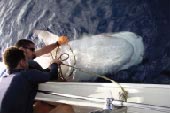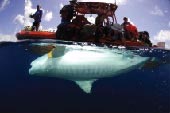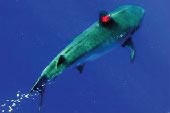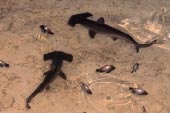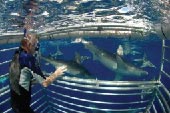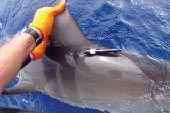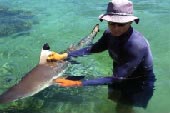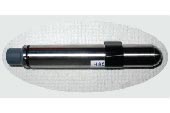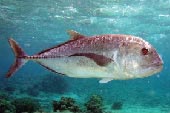| Electronic Tags Overview |
| |
| Overview |
| We use two broad classes of electronic tags (transmitters & dataloggers) in our studies. Transmitters send data from their host animal remotely via sound or radio waves to a receiver. Dataloggers store all of their data in onboard memory and must be recovered from the animal for downloading. The major trade-off between these two approaches is dataloggers generally provide much larger quantities of data than transmitters, but datalogger recovery is not guaranteed, hence the desirability of remote transmission. Some electronic tags combine both datalogger and transmitter in a single device. For example, Pop-Up Archival Satellite Tags (PATs) store large volumes of data in onboard memory and summarize data for lower-volume transmission to satellites. If PATs are physically recovered then the full record can be downloaded from memory. |
| Many electronic tags obtain environmental information via a suite of sensors. The most commonly used sensors measure depth (pressure), temperature, salinity (conductivity) and light levels. Sensor information helps biologists to better understand the environment in which animals live. For example, depth and temperature sensors can tell us whether a shark lives primarily in the warm surface waters of the ocean, or is a frequent visitor to deeper, colder zones. One of the frontiers in electronic tag science is development of new types of sensors (e.g. pH sensors) to provide new insights into important aspects of shark & fish behavior such as how often they feed. |
| On this page we provide brief descriptions of the different electronic tags used in our shark and reef fish studies. These run the gamut from the most well-established types of electronic tag to prototypes on the very frontiers of this type of scientific research. |
| |
| |
| |
| Acoustic Pingers |
| The simplest version of the acoustic transmitter is the ‘pinger’. The ‘pinger’ produces ultrasonic pings that can be heard using a hydrophone (underwater microphone) and receiver. This was the original type of fish tracking tag. Pingers are attached to sharks and fishes which are then followed in a vessel equipped with a hydrophone and receiver. This process is known as ‘active tracking’ because the researcher actually follows the fish to find out where it goes. More sophisticated versions of these tags include onboard sensors (typically pressure and temperature) to provide depth and water temperature information from the fishes track. The depth and temperature information is encoded in the acoustic pings transmitted from the tag. |
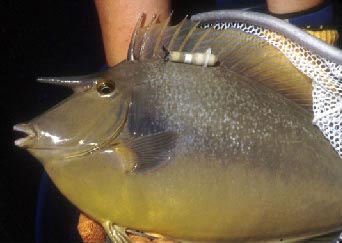 |
| Bluespine unicornfish (Naso unicornis) with externally attached acoustic pinger. This example was manufactured by Vemco Ltd, Canada. |
|
|
| |
|
| Passive Acoustic Monitoring |
| Passive acoustic monitoring uses the same basic transmitter-receiver technology as active tracking but is for longer-term (months or years) studies. This system consists of uniquely identifiable ultrasonic transmitters that are surgically implanted into sharks and fishes to ensure longer retention. These transmitters are then detected by underwater receivers stationed at various locations on the sea floor. The receivers are deployed on subsurface moorings and continuously listen for transmitters, 24 h a day 365 days of the year. When a tagged shark comes within detection range of a receiver (detection radius is up to 1 km depending on transmitter type), its unique ID code is recorded, together with the date and time. The records from receivers at different locations are combined to create an overview of shark movement patterns. |
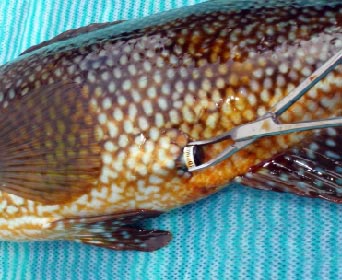 |
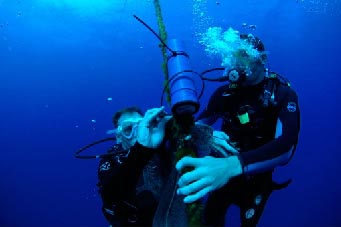 |
| Surgical implantation of a coded acoustic transmitter manufactured by Vemco Ltd. |
Divers deploying an underwater receiver manufactured by Vemco Ltd. |
|
| |
| Satellite Transmitters - SPOT Tags |
| Satellite tags are detectable over broad geographic areas and remotely relay information to satellite arrays. These tags utilize radio transmissions, requiring the tag to have contact with air to send data (hence satellite tags must be externally attached). External attachment makes satellite tags prone to damage and premature shedding. For studies of shark movements, Smart Position or Temperature Transmitting Tag (SPOT tags) are commonly attached to the dorsal fin. SPOT tags transmit a signal to the Argos satellite array whenever the dorsal fin breaks the surface of the water. These transmissions resulted in geo-location estimates with location accuracies that range from a few hundred meters to ‘somewhere on planet Earth’. |
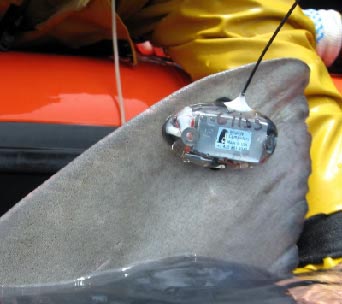 |
| SPOT tag attached to the dorsal fin of a tiger shark (Galeocerdo cuvier). Tag in photo manufactured by Wildlife Computers, USA. |
|
|
| |
| Satellite Transmitters - PAT Tags |
| Popup Archival Transmitting tags (PATs) collect and store temperature, depth and light intensity data as the host animal swims through the ocean. At a pre-programmed date and time, the PAT detaches from its host, floats to the surface and uploads stored data to the Argos satellite array. PATs store large volumes of data in onboard memory and summarize these data for lower-volume transmission to satellites. If PATs are physically recovered then the full record can be downloaded from memory. Because day length changes with latitude, and sunrise and sunset times change with longitude, light level data can be analyzed to determine where the host animal travelled between PAT deployment and release. Light-level geolocation works best with animals which move over long distances. |
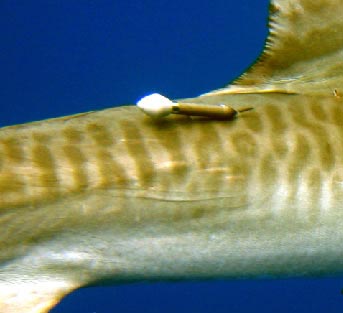 |
| PAT tag deployed on a tiger shark (Galeocerdo cuvier). Tag in photo manufactured by Wildlife Computers. |
|
|
|
| |
| Business Card Tag |
| The Business Card Tag (BCT) is a prototype datalogging tag manufactured by Vemco Ltd. The BCT combines both acoustic receiver and transmitter in a single device, allowing BCTs to swap identification codes with one another. This provides an important new tool for quantifying inter-animal interactions, shedding light on how frequently, and at what times marinal animals encounter one another. In addition to ‘talking’ to one another, BCTs can also detect other Vemco transmitters, and are themselves detectable by other Vemco receivers. |
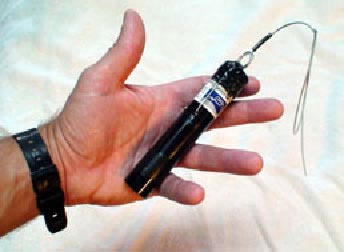 |
| The Vemco Business Card Tag manufactured by Vemco Ltd. |
|
|
| |
| Accelerometer Dataloggers |
| Tri-axial accelerometer dataloggers measure accelerations due to gravity along three axes, providing a highresolution, three-dimensional record of animal movements. These devices are providing important new insights into animal behavior. We have been collaborating with colleagues from the Ocean Research Institute in Tokyo, and using these devices to shed new light on shark swimming behavior. The package in the picture includes both accelerometer and a digital camera which provides a ‘sharks eye’ view of the environment. This enables us to compare the swimming behavior with what the shark is seeing as it swims through the ocean. |
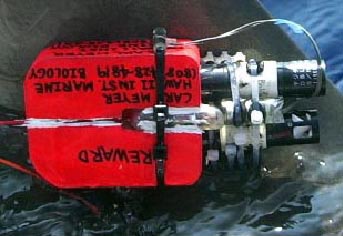 |
| Accelerometer datalogger and digital camera deployed on a tiger shark (Galeocerdo cuvier). Devices manufactured by Little Leonardo Co., Japan. |
|
|
|
|
| pH Datalogger/Transmitter |
| pH tags are a valuable new tool for quantifying shark feeding. These devices are placed in the sharks stomach were they measure changes in acidity over time. The shark stomach is generally very acid, but the pH changes dramatically when the shark ingests food. This provides a convenient pH signal indicating a shark has fed. In recent decades we have learned a lot about where sharks travel but in most cases we don’t know when and where they are feeding. pH tags can help us to fill in the blanks. |
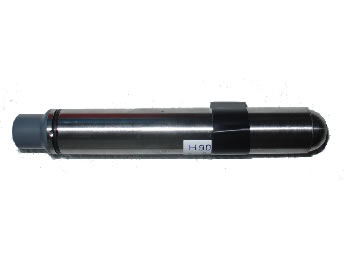 |
| A stomach pH transmitter manufactured by Vemco Ltd. |
|
|
| |
| Hydrophone Tags |
| Hydrophone tags such as the Bioacoustic Probe are devices which record underwater sounds. In effect they are like an underwater tape-recorder. The ocean is a very noisy place, and sounds can provide a lot of information about an animals environment and behavior. Hydrophone tags can tells us what animals are hearing and what sounds they themselves are making. We can use these tags to learn about important behaviors such as feeding and mating. |
 |
The Bioacoustic Probe hydrophone tag manufactured by Greeneridge Sciences, USA. |
|
|
| |

